Personal Finance
If you don't have this much saved by 45, you are falling behind

Published:
Last Updated:

It’s always a good practice to check in with how your retirement savings stack up against the averages. Undoubtedly, comparing to the averages can only take you so far. Everybody has their own unique lifestyles, living conditions, and, most importantly, set of goals. Just because somebody is well ahead of their retirement savings journey doesn’t mean it’s easy sledding from here on out.
On the flip side, falling behind on retirement savings goals isn’t all too big a deal if you’re in your 40s. There’s still a ton of time to make up for last time, given you’re probably not even close to the finish line, assuming you plan to retire at some point in your mid-60s.
In any case, a check-in with the averages can give you a fairly rough idea of how you’re doing. And though I wouldn’t make drastic changes unless you have little or no retirement savings, I do think the slight changes can make all the difference over the long term. Perhaps some of the older Millennials, who are now in their early 40s, can pass up on the avocado toasts and spruced-up lattés to shore up a bit of cash to help pad their savings.
Of course, it may not be worth your while to give up the morning café routine if it brings a great deal of joy. If, however, such a convenient treat doesn’t bring you great utility, you may wish to make changes to get the most bang for your buck. In any case, there is larger fruit for most people in their 40s to pick if they’re looking to level up their retirement savings plans.
In this piece, we’ll take a quick look at the average retirement balance for someone in their mid-40s and give you tips and tricks for catching up or, if you’re well ahead of the game, staying ahead and perhaps pulling ahead further.
According to data provided by Edward Jones, you should shoot for having four times your annual salary. So, if you’re pulling in $50,000 a year, having $180,000-225,000 deserves a pat on the back. As always, skewing toward the higher end is more conservative, given the inflationary battle we’ve all had to deal with in these past two and half years. While inflation has fallen significantly in recent quarters, there’s no telling if it’ll rear its ugly head again in the near future as the Fed winds down on rates.
If you’ve got more than $225,000 on a $50,000 per-year income, you’re well on track, but you may wish to consider taking steps to bring your savings into overdrive to perhaps retire a few years earlier than expected. As always, check in with a personal finance pro before committing to any plan!
The following tips are just that: tips. Don’t view them as a one-size-fits-all type of solution for the masses.

Retirement savings is a marathon, not a race. So, if you’ve already got four times your salary banked, shoot for five or six times in a suitable timeframe that’s sustainable in accordance with your lifestyle. Given the inflationary hurricane we’ve grappled with to this day, it’s understandable that your nest egg may have grown at a slower pace. And if things have gotten really bad, you may have had to crack it open a bit to meet the rising costs of everything.
There’s no shame in doing this, especially since you can return to growth mode once conditions normalize. But if you’re finding it difficult to contribute to retirement savings given your climbing personal budget, perhaps it makes sense to consider taking action with your invested sum to ensure it’s in an optimal spot.
First, if you’re not already investing in stocks, bonds, and alternative assets, you may wish to consider doing so, especially if you’re more than 20 years away from retirement. If you’re in your 40s and are shooting to retire at 65, you still have time on your side. And you should make the most of the time by investing in securities that can best help your nest egg grow.

Bonds are fine and dandy, but if you want better real returns (after inflation), stocks and ETFs (exchange-traded funds) are the way to go. If you’re heavy on the mutual funds charging 2% or more in annual fees, perhaps it’s time to rotate into a low-cost index fund. A percent or two saved in investing fees may not seem like much. However, after compounding over decades, it could mean the difference between retiring at 65 and 70.
Either way, I’d shoot for an index fund that mirrors the S&P 500 — the Vanguard S&P 500 ETF (NYSEARCA:VOO) has a 0.03% expense ratio — with a total expense ratio below 0.1%. That way, you’ll be able to participate in the markets without having to pay a fat fee to a money manager.
Retirement planning doesn’t have to feel overwhelming. The key is finding expert guidance—and SmartAsset’s simple quiz makes it easier than ever for you to connect with a vetted financial advisor.
Here’s how it works:
Why wait? Start building the retirement you’ve always dreamed of. Click here to get started today!
Thank you for reading! Have some feedback for us?
Contact the 24/7 Wall St. editorial team.